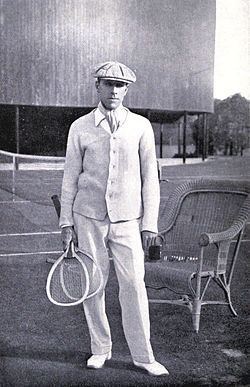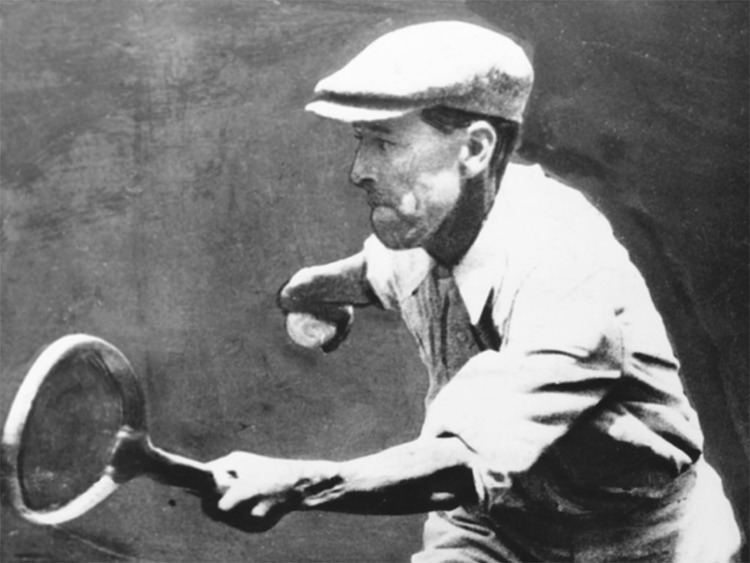Full name Norman Everard Brookes Name Norman Brookes Grand slams won (singles) 3 Weight 68 kg | Retired 1928 Height 1.8 m Role Tennis player | |
 | ||
Plays Left-handed (1-handed backhand) Highest ranking No. 1 (1907, Karoly Mazak) Similar People Tony Wilding, Gerald Patterson, Martina Navratilova, Jana Novotna, Arantxa Sanchez Vicario | ||
Int. Tennis HoF 1977 (member page) | ||
Video norman brookes forehand and serve
Sir Norman Everard Brookes (14 November 1877 – 28 September 1968) was an Australian tennis player. Brookes was a world No. 1 ranked player and later president of the Lawn Tennis Association of Australia. During his career he won three Grand Slam singles titles, Wimbledon in 1907 and 1914 and the Australasian Championships in 1911. Brookes was part of the Australasian Davis Cup team that won the title on six occasions. The Australian Open men's singles trophy, the Norman Brookes Challenge Cup, is named in his honour.
Contents
- Video norman brookes forehand and serve
- The making of the norman brookes challenge cup
- Biography
- Tennis career
- Australian rules football career
- Honours
- References

The making of the norman brookes challenge cup
Biography
Brookes was born in Melbourne to Catherine Margaret (née Robinson) and William Brookes. His older brothers, Herbert and Harold, were prominent businessmen. Their father, an English immigrant, had become rich from gold mining in the Bendigo area. Brookes received a private education at Melbourne Grammar School. On leaving school, he went to work as a clerk at Australian Paper Mills, where his father was managing director, and was on the board himself within eight years.
Brookes married 20-year-old Mabel Balcombe Emmerton, the daughter of Harry Emmerton, a solicitor, on 19 April 1911 at St Paul's Cathedral in Melbourne. They had three daughters.
During World War I he served as commissioner of the Australian Red Cross in Egypt. He died in South Yarra, Victoria, in 1968.
Tennis career
As a youth Brookes played regularly on the court of the family mansion in Queens Road, Melbourne and nearby, at the Lorne St courts, he studied the strokes and tactics of leading players and was coached by Wilberforce Eaves.
Brookes was the first non-British player and the first left-hander to win the men's singles title at Wimbledon. He won the men's singles twice, first in 1907 and again in 1914. He also won the doubles in each of those years with New Zealander Anthony Wilding, whom he beat in the 1914 singles final. He was a major figure in establishing the Australian Open (known as the Australasian Championship until 1927), which he won in 1911. Brookes is considered to have been a World No. 1 player in the 1900s.
Brookes played 39 Davis Cup matches for Australia/New Zealand and the Australian Davis Cup Team between 1905 and 1920.
In May 1914 he won the singles title at the Surrey Lawn Championships in Surbiton, defeating Gordon Lowe in the final in five sets.
Brookes was instrumental in the development of Kooyong as a tennis centre. In 1926 he became the first president of the Lawn Tennis Association of Australia, a post he held for the next 29 years until his retirement in June 1955.
Australian rules football career
Brookes was also an Australian rules footballer in his youth, particularly for Melbourne Grammar School.
Honours
Norman Brookes was knighted "in recognition of service to public service" in 1939. His wife, Mabel, Lady Brookes (CBE in 1933) became Dame Mabel Brookes (DBE) in 1955 for her work in charities and social causes.
The trophy for men's singles at the Australian Open, the Norman Brookes Challenge Cup, is named in his honour.
He was inducted into the International Tennis Hall of Fame in 1977.
In 1981 he was honoured on a postage stamp issued by Australia Post depicting a cartoon image by Tony Rafty.
